Zosui (雑炊), or ojiya (おじや), is a rice soup or a Japanese version of congee. Rice is cooked in flavoured soup with vegetables, egg and sometimes meat or fish. It is often made using the soup from the hot pot to wrap up the wonderful meal of the day. You can imagine how good the soup from the hot pot would be, can’t you?
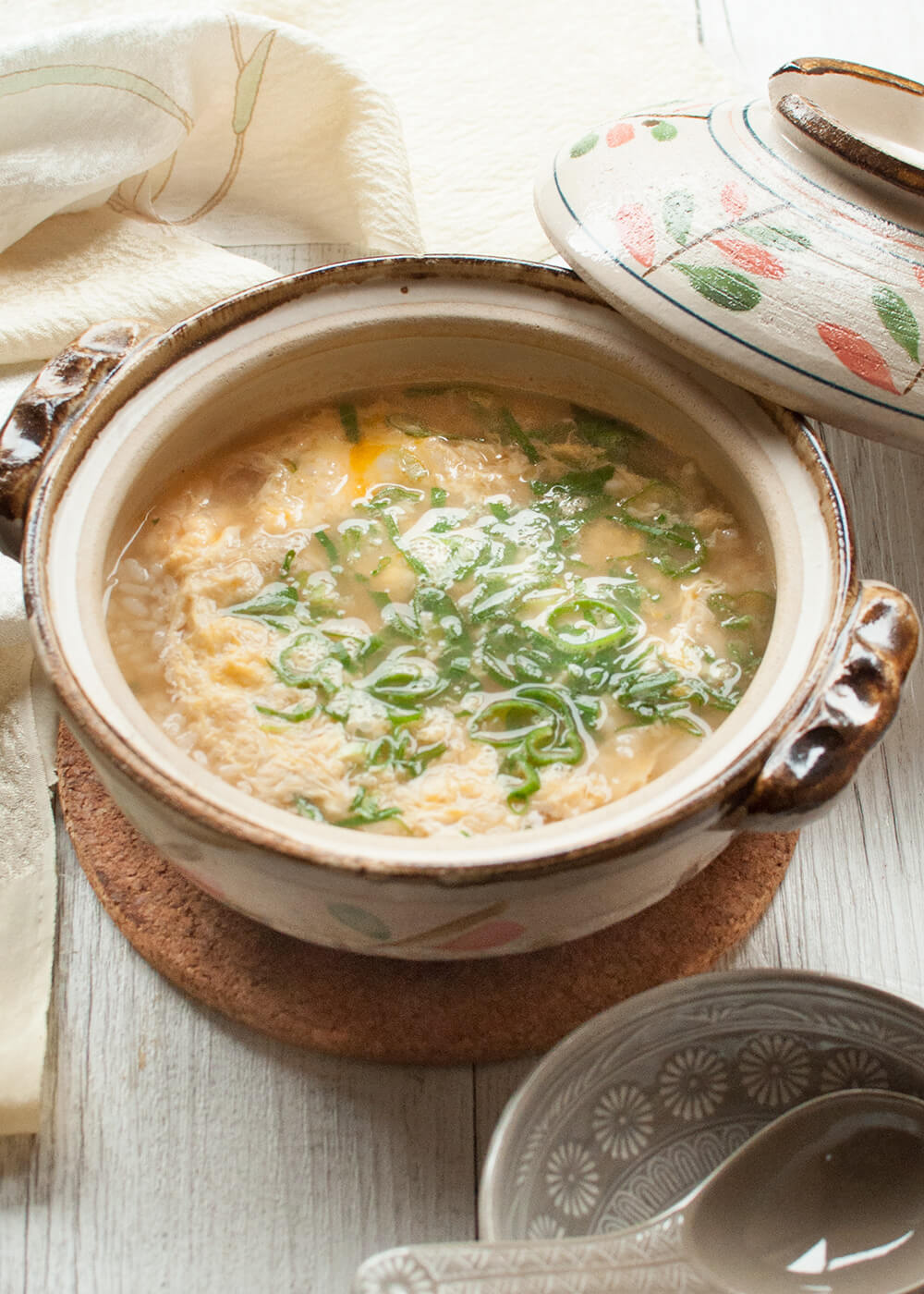
Unlike congee, zosui (雑炊, Japanese rice suop) is made from pre-cooked rice. The soup usually has either soy sauce flavour or miso flavour. It is originally cooked at home from leftover rice & vegetables.
It is also called ojiya (おじや) and my children are used to calling it ojiya. That is because I called it ojiya instead of zosui when they were little. I felt that the word “zosui” sounded more difficult than “ojiya”.
When I was a school kid, my grandmother was living with us. I often got home from school feeling hungry and my grandmother made zosui with the miso soup left over from the morning. She simply added cooked rice to it and heated it up, sometimes with beaten egg.
Such a simple meal but it really was delicious and zosui is still one of my favourite dishes. I mentioned zosui in last week’s post, Yosenabe. Can you imagine how good it would be to make a rice soup from the hot pot soup stock? It is so good and that’s why I am posting zosui today.
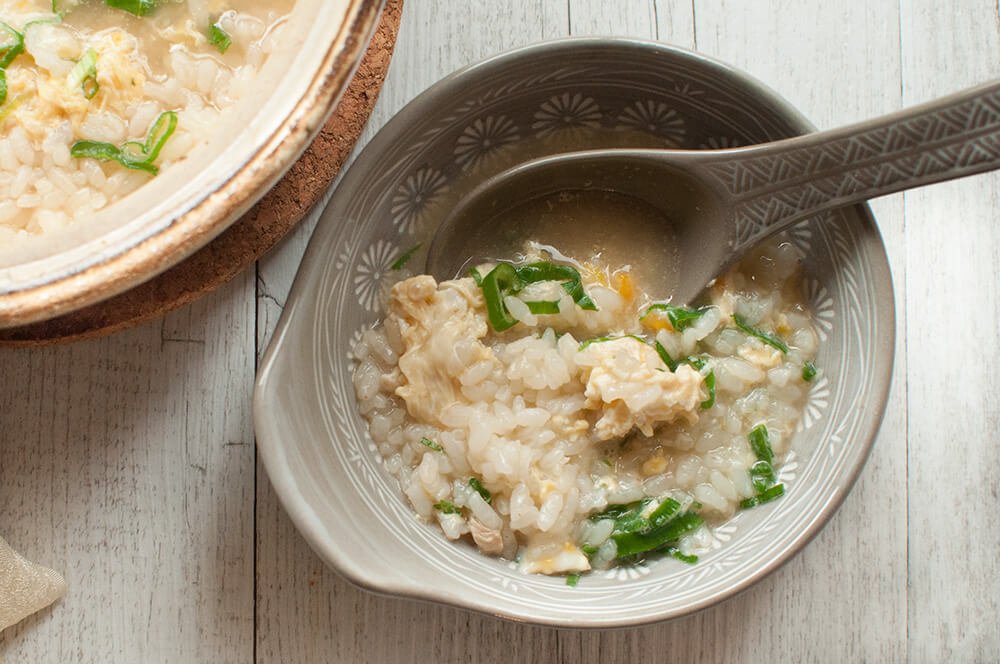
When my children were little, they did not enjoy yosenabe, perhaps because the flavour was subtle unlike sukiyaki which has a strong sweet soy sauce flavour. In the case of Nagi, I think that it was close to “dislike” at the time. But our house rule was that you must not say “I don’t like this” and should not refuse to eat what’s been served.
Nagi made an extra effort to get through yosenabe quickly so that she could have ojiya at the end. She loves ojiya. She is happy to skip the main meal, i.e. hot pot and just have ojiya. To this day, she still tries to skip yosenabe and just have ojiya.
Basic zosui soup is made of dashi stock and soy sauce or miso paste. Sometimes, a small amount of sake or mirin is added. If you add chicken or seafood to it, it will give an extra flavour to the soup. But the simplest zosui can just be the cooked rice and beaten egg. You can be creative and add different vegetables to it though.
Just make sure that the vegetables are sliced into smaller pieces or strips to blend in with the rice nicely. Chicken or fish can be cut into small bite size pieces. Chicken can even be almost like mince (ground).
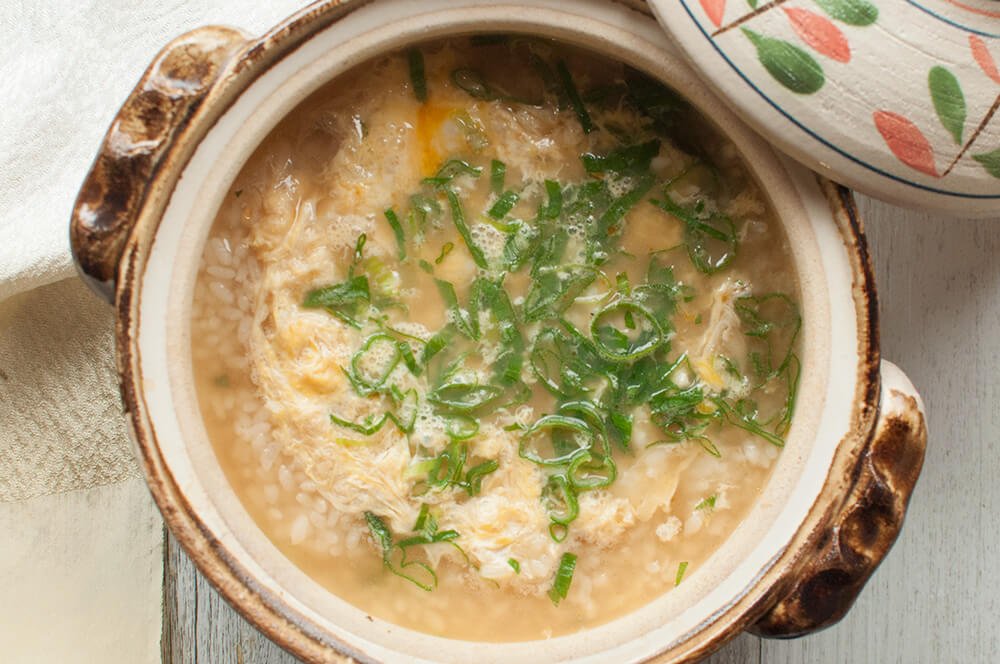
If you use the soup left over from the yosenabe that I posted last week, you would not usually need to adjust the flavour at all because yosenabe is made with flavoured soup stock. All you need is to add cooked rice to it, then add beaten egg, sprinkle with chopped shallots (scallions).
So here is a recipe to make a Japanese rice soup, zosui after having yosenabe. I used a smaller clay pot to make rice soup individually, instead of continuing to use the large pot used in my Yosenabe recipe. It was simply because my yosenabe pot was too large to make two people worth of rice soup. If you have a pot of just the right size, you needn’t to change the pot.
In case you just want to make only zosui, I also added a recipe to make zosui from scratch. See the photo of sozui made from scratch below the recipe.
Yumiko![]()
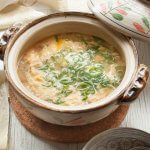
- 500ml (16.9oz) soup stock from Yosenabe (note 2)
- 200g (7.1oz) cooked rice (can be frozen)
- 2 beaten eggs
- 4 tbsp finely chopped shallots (scallions)
- 500ml (16.9oz) dashi stock (note 4)
- 2 tsp soy sauce
- A pinch of salt
- 40g (1.4oz) carrot, julienned into 2.5cm (1”) lengths
- 3 small shiitake mushrooms thinly sliced
- 200g (7.1oz) cooked rice (can be frozen)
- 2 beaten eggs
- 4 tbsp finely chopped shallots (scallions)
-
Heat the soup stock over high heat.
-
When it has started boiling, add rice and mix well ensuring that each grain is separated in the soup.
-
When it has started boiling again, reduce the heat to medium and add egg, spreading on the surface evenly (note 5), then place a lid on.
-
Cook for 15-30 seconds or until egg is nearly cooked (note 6).
-
Sprinkle shallots over and serve immediately.
-
Add dashi stock, soy sauce and salt in a pot and bring it to a boil.
-
Add carrots and shiitake mushrooms. Cook for a couple of minutes or until the vegetables are cooked.
-
Add rice and mix well ensuring that each grain is separated in the soup.
-
When it has started boiling again, reduce the heat to medium and add egg spreading on the surface evenly (note 5), then place a lid on.
-
Cook for 15-30 seconds or until egg is nearly cooked (note 6).
-
Sprinkle shallots over and serve immediately (see the photo below this recipe).
1. I usually use just egg and chopped shallots to make a very plain zosui like this. This is because I already had all kinds of vegetables, meat and seafood in yosenabe.
But if you are like my son who wants more ingredients in zosui, you could either reserve some yosenabe ingredients or add freshly prepared ingredients such as mushrooms, tofu (cut into small dice), julienned carrots.
If you are adding extra ingredients, you need to cook them before adding rice.
2. The amount of soup left over from yosenabe varies depending on how the yosenabe was cooked and eaten. If you don’t have enough soup stock left, you can add water and adjust the flavour with salt.
3. I used only carrots and shiitake mushrooms, but you can use different ingredients, even add chicken or seafood if you like.
Chicken should be cut into small bite size pieces. You can even dice it into smaller sizes. If adding fish, I would recommend using fillets with the skin on, cut into bite size pieces.
4. Please refer to Home Style Japanese Dashi Stock. You can also use instant dashi stock for this. Please follow the instructions on the packet of the instant dashi for the ratio of water and instant stock.
5. If you use a measuring cup or a bowl with a pour spout on it, you can spread the egg evenly. Try to draw swirls on the surface.
If you don’t have a cup/bowl with a spout, attach a pair of chopsticks or a fork to the rim of the bowl and tilt the bowl to let the egg flow along the chopsticks/fork.
6. The cooking time here depends on the type of pot you are using, strength of heat and your preference as to how much the egg should be cooked.
If you are using a clay pot (donabe), like in my photo, you hardly need to cook it before turning off the heat as it continues to cook after turning the heat off for a long time. With my donabe, I place the lid on after adding the egg and turn off the heat.
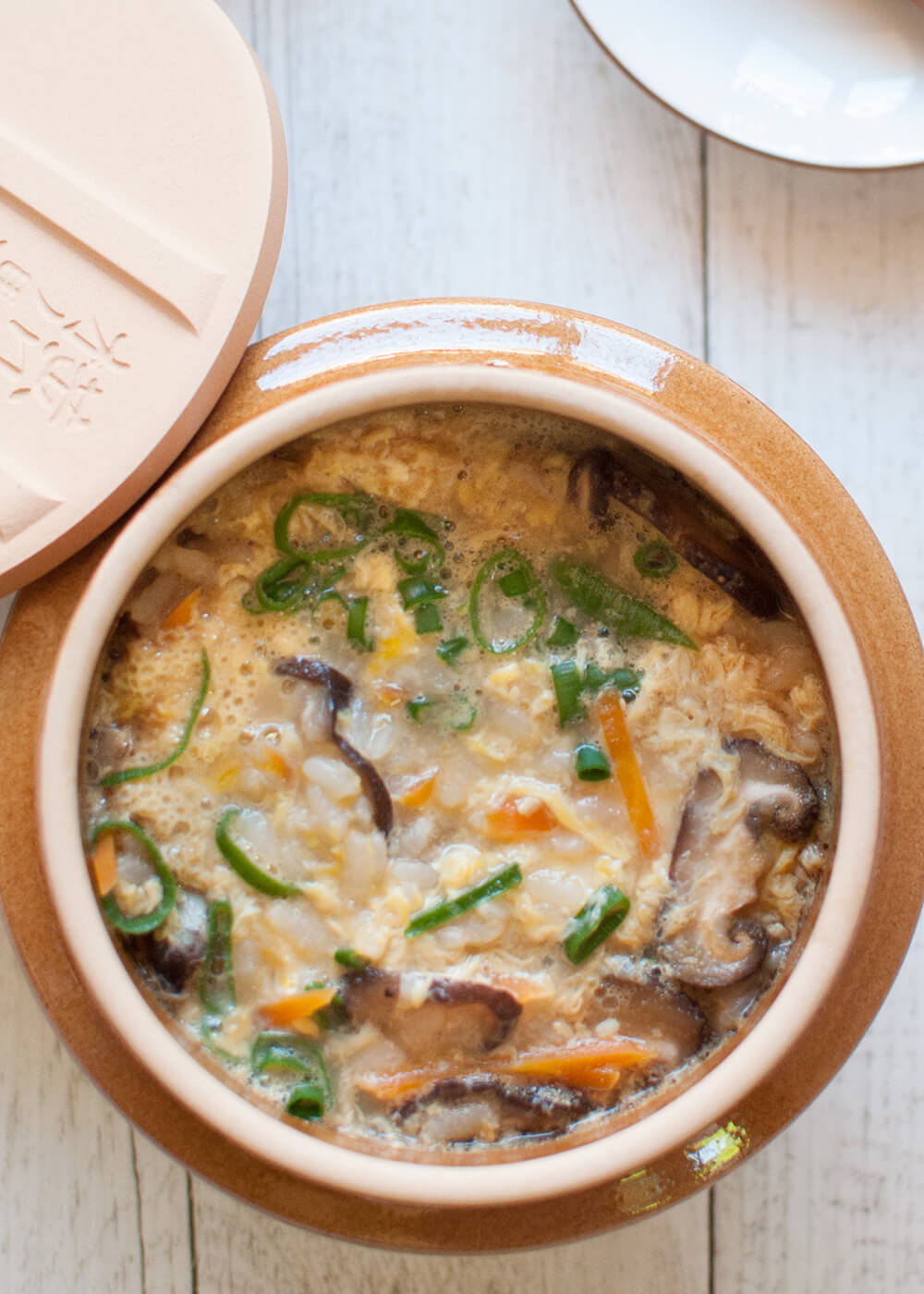
Ohh! I add rice to egg drop soup (which the recipe I use looks similar to kakitama-jiru) and miso soup on days I just need a comfort dish. I also love it when I am sick. I had no idea doing so was common anywhere. I should try adding mushrooms sometime ♥
Well, you knew the traditional Japanese way!
Deliciosas suas receitas!! parabéns!!
Hi Gelson, Obligado!
Unlike porridge, zosui (雑炊, Japanese rice soup) is made from cooked rice. The soup usually has a soy sauce or miso flavor. I would often come home from school hungry and my grandmother would make zosui with leftover miso soup in the morning. For clearer information, you can visit our website https://kulinerekstrim.com/
Hi Reza, I said exactly the same thing in my post, including my grandmother making zosui with leftover miso soup!
I enjoy your site very much. I very much appreciate your recipes, including the detail of information.
It is clear that understand the value of healthy food.
Please continue to post as many meatless recipes as possible (or those easily adaptable to no-meat).
I prefer not to provide my email (therefore it is fake).
Thank You!
Mike B., Eugene, Oregon –USA
Hi Mike, thanks for a kind and encouraging message!
This was very nice! Great for when you are under the weather. I made it for my kids today since my son wasn’t feeling well. They told me it was better than their ばあば’s version. That’s the ultimate compliment. 😂
Hi Veronica, wow, I am honoured!